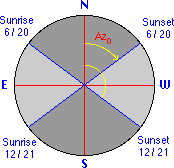|
|
GeoAstro Applets |
Astronomy |
Chaos Game |
Java |
Miscel- laneous |
Physics Quiz |
Who is Who ? |
|
Planet Applet Applet Details Planetary Events Solutions |
Solar,
lunar, and planetary events to discover and to explore
(read
the explanatory
details
before)
Solutions:
|
|
|
|
|
|
|
|
2004,
Mar 20 at about 06:37 UT, JD 2453084.776 |
|
4. Find the date and time of summer solstice |
summer
solstice (northern hemisphere): 2004,
Jun 21 at about 00:50 UT |
|
|
2004,
Mar 20 at about 06:37 UT, JD 2453084.776 |
|
6. Find the altitude of the noon Sun at summer and winter solstice: |
In
Berlin (52.52° N, 13.41° E), 2004: |
|
7. Determine the azimuth of the rising Sun at summer and winter solstice:
|
In
Berlin (52.52° N, 13.41° E), 2004:  |
|
8. Find the date and time of perihelion 2004 |
Perihelion:
2004, January 4 at about 18 UT |
|
9. Find the date of Easter 2004 |
1)
2004, Mar 20, 2) Mon 2004, Apr 5, |
|
10. Explore the Transit of Venus on 2004, June 8 |
The
transit will be visible from Europe |
|
11. Explore the visibility of the inner Planets |
Mercury:
before sunrise from end of Mar to beg. of Apr |
|
12. Find the duration of the longest day of 2004 for your location |
Berlin
(52.51° N): |
|
13. Find the the day of earliest and latest sunrise 2004 for your location: |
For
Berlin (52.51° N), 2004: |
|
14. Find the date and time of New Moon 2004 |
Jan
21, 21:05 UT, LSun=LMoon=301.17° (21:05) |
|
15. Check the duration of a Synodic Month |
This
is the period of time which elapses between the New Moon and the next. |
|
16. Determine the duration of a Draconic Month |
The
Draconic (Draconitic or nodical) Month is the interval of time
between two successive transits of the Moon through its ascending node
(heliocentric latitude changing from - to +): |
|
17. Determine the duration of an Anomalistic Month |
The
anomalistic month is the time between perigee passages. |
|
18. Explore the Total Lunar Eclipse of 2004, Oct. 28
|
Maximum
eclipse at about 3:10 UT |
|
|
2004
Jan 20: declination -27.1° |
|
|
|
|
|
Tropical
Month: period of revolution of the moon around the earth in reference
to the vernal equinox |
|
|
|
|
|
|
|
|
|
Synodic |
|
|
|
|
|
|
|
Anomalistic |
|
|
|
|
|
|
|
Draconitic |
|
|
|
|
|
|
|
Sidereal |
|
|
|
|
|
|
|
Tropical |
|
|
|
|
|
|
Month (Wikipedia)
To be continued ...
© 2003-2009 J. Giesen